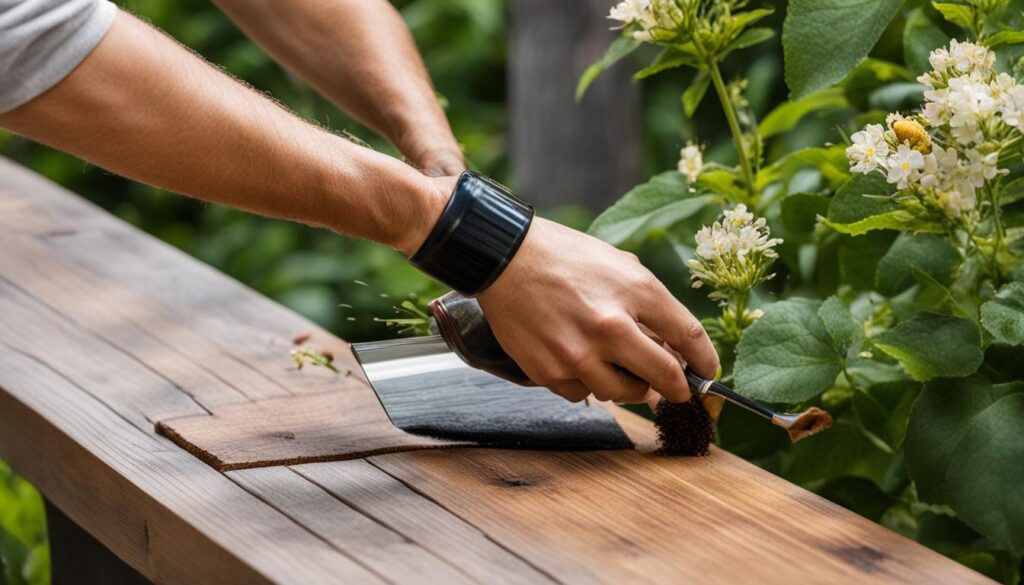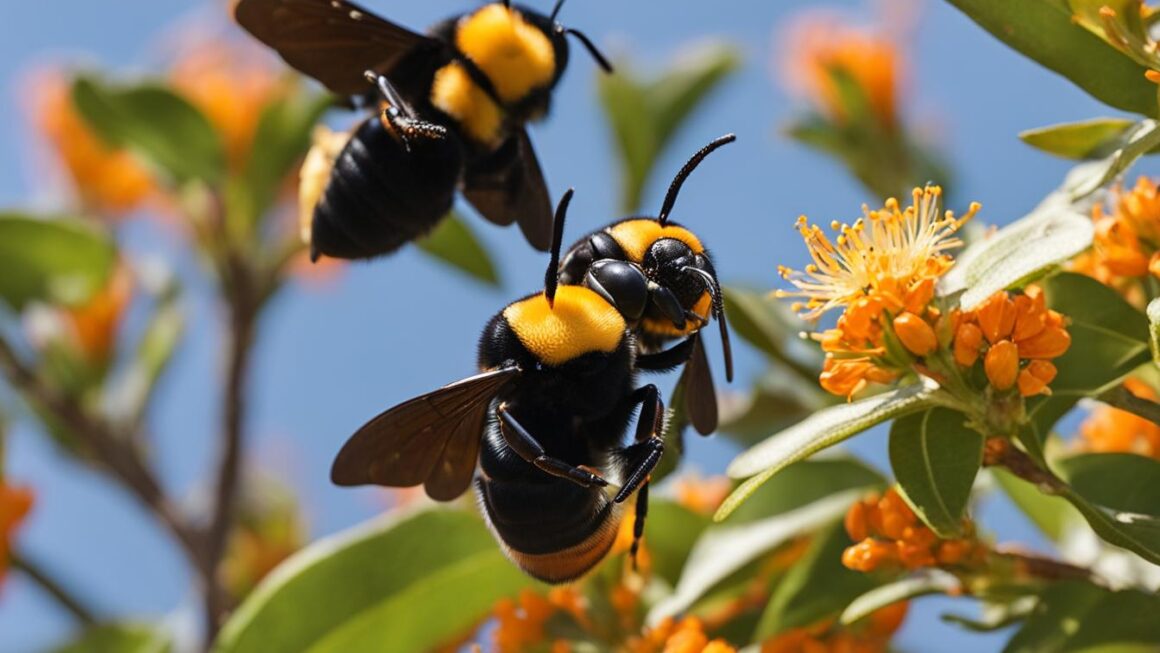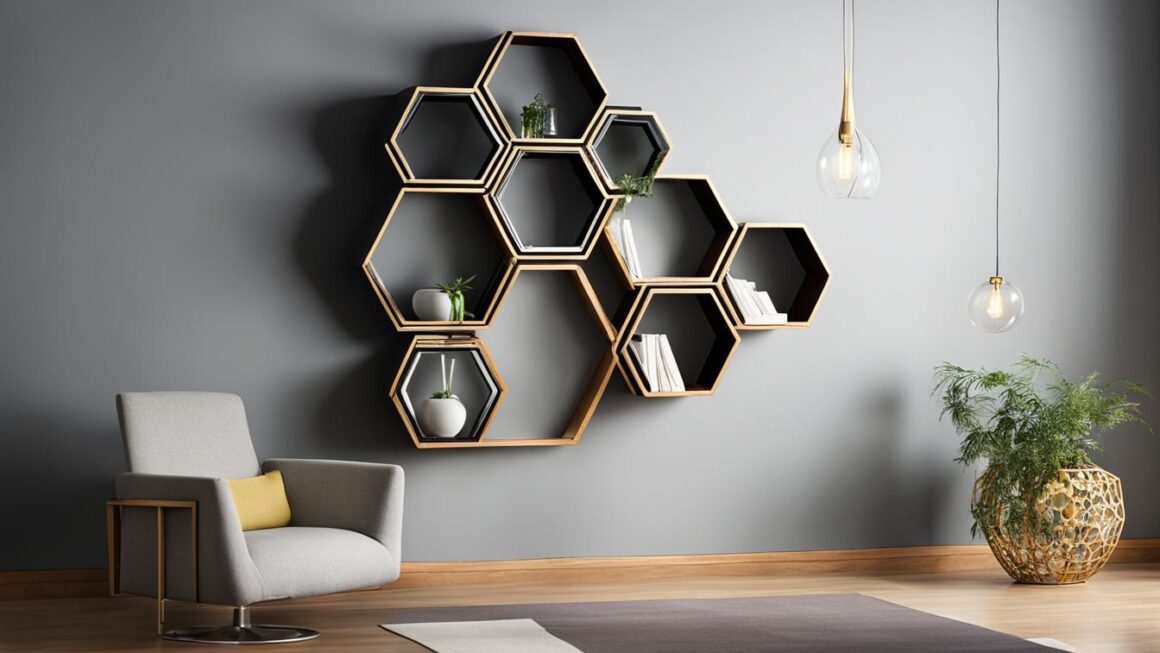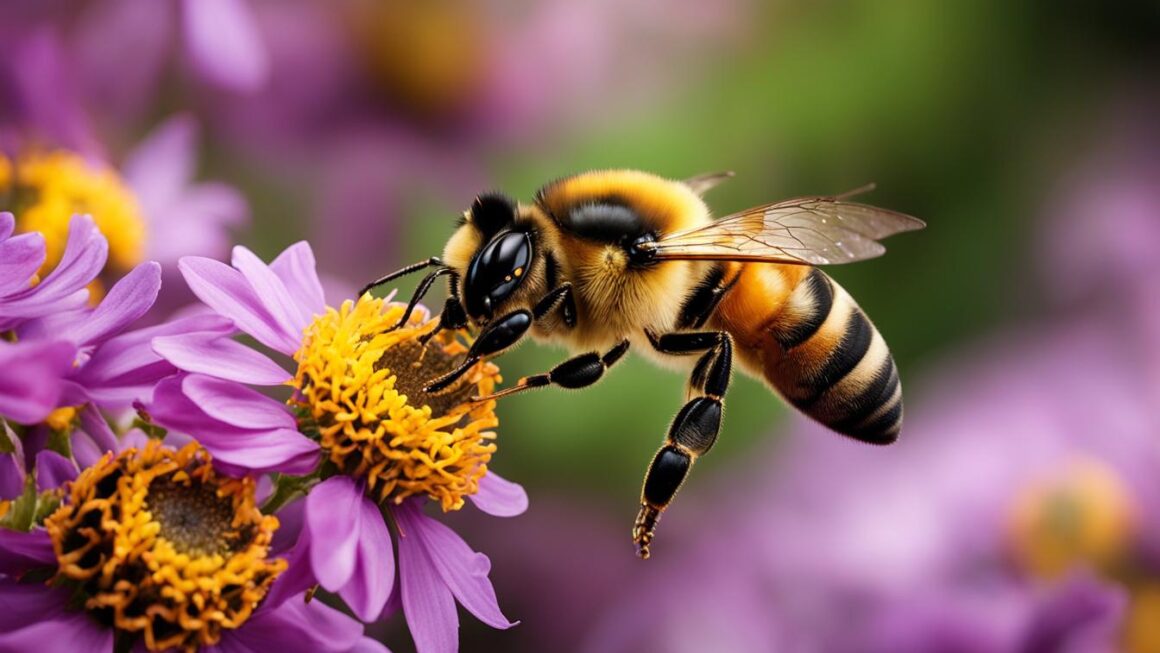Welcome to our comprehensive guide on carpenter bees in Florida. These beneficial insects are an essential part of the ecosystem, playing a crucial role in pollination. In this guide, we will explore their habits, treatment solutions, and the risks they pose. Whether you are dealing with a carpenter bee infestation or simply want to learn more about these fascinating creatures, we’ve got you covered.
Key Takeaways:
- Carpenter bees are beneficial insects that aid in pollination.
- They can be found in Florida during the spring.
- Female carpenter bees have a black abdomen, while males have more yellow markings.
- Signs of an infestation include small holes in wood structures and bees hovering around the yard.
- Carpenter bees can cause damage to homes if they nest in the wood.
Identifying Carpenter Bees and Their Habits
One of the key signs of a carpenter bee infestation is small holes in wood structures, especially unpainted and weathered wood. These holes are created by female carpenter bees for laying their eggs. Carpenter bees tend to use the same nest from season to season, rather than creating new nests. They also collect materials such as sawdust and pollen to bring back to their nests, which can result in small piles of debris on the surface of the wood.
Carpenter bees are often confused with bumble bees, but there are some differences between the two. Carpenter bees are solitary insects that nest in wood, while bumble bees nest in large colonies and prefer to build their nests close to the ground. Additionally, carpenter bees have a smooth abdomen, while bumble bees have a fuzzy abdomen.
Comparing Carpenter Bees and Bumble Bees:
| Carpenter Bees | Bumble Bees |
|---|---|
| Build nests in wood | Build nests close to the ground |
| Smooth abdomen | Fuzzy abdomen |
Understanding these signs and differences can help homeowners identify carpenter bees and take appropriate action to address an infestation. It is important to be proactive in dealing with carpenter bees to prevent damage to wood structures and maintain a safe and pest-free environment.
Understanding the Risks of Carpenter Bees
Carpenter bees may be beneficial for pollination, but they can also pose risks to your home. These bees have the habit of nesting in wood, creating tunnels that can weaken the structural integrity of the affected area over time. The damage caused by carpenter bee tunnels can lead to rotting and potential collapses if left untreated. Additionally, the presence of carpenter bees can attract woodpeckers, who may cause further damage in their attempts to access the bee nests. Therefore, it is important to address a carpenter bee infestation promptly to prevent further damage to your property.
“If left untreated, carpenter bees can cause structural damage to your home by weakening the wood.”
It is essential to note that carpenter bees are generally not aggressive and are unlikely to sting unless directly provoked. However, their nesting habits and potential for property damage make it necessary to take action if you suspect a carpenter bee infestation.
Table: Comparison of Carpenter Bee Damage and Extermination Methods
| Damage | Extermination Methods |
|---|---|
| Weakening of wood structures | Professional bee removal services |
| Potential collapses | Safe and humane extermination techniques |
| Attracting woodpeckers | Natural deterrents and prevention strategies |
By understanding the risks associated with carpenter bees and taking preventive measures, you can protect your home from potential damage. Regular inspections, treating or painting wood surfaces, and removing decaying wood can help deter carpenter bees from nesting in the first place. Furthermore, seeking professional help for carpenter bee removal ensures that the infestation is properly addressed without causing harm to the environment. By prioritizing the preservation of carpenter bees and taking proactive steps, you can maintain a balance between protecting your property and supporting the important role these bees play in pollination.
Preventing and Treating Carpenter Bee Infestations
Carpenter bees can be a nuisance when they choose to nest in your home or other wooden structures. However, there are several steps you can take to prevent and treat carpenter bee infestations effectively.
Prevention
One of the most effective ways to prevent carpenter bee infestations is by painting or treating any exposed wood surfaces near your home. Carpenter bees are more attracted to unpainted or untreated wood, so applying a coat of paint or weather-resistant finish can make the wood less appealing to them. It’s also important to repair any damaged or rotting wood, as these areas are more likely to attract carpenter bees.
Another preventative measure is to provide alternative nesting options for carpenter bees. Placing cardboard or toilet paper tubes in trees and surrounding them with flowers can attract the bees away from your home and into these designated areas.
Treatment
If you already have a carpenter bee infestation, there are several treatment options available. One method is the use of carpenter bee traps. These traps are designed to lure the bees inside, where they become trapped and can be safely removed.
Another treatment option is to locate the carpenter bee nests and plug the holes. This can be done using wooden dowels coated in carpenter’s glue or a similar adhesive. Blocking off the nesting sites prevents the bees from re-entering and encourages them to find alternative locations.
It’s important to note that if you’re dealing with a severe infestation or are unsure about how to effectively treat the problem, it’s best to seek professional help. Pest control companies that specialize in bee removal can provide safe and effective solutions for removing carpenter bees from your property.
| Treatment Method | Description |
|---|---|
| Carpenter Bee Traps | Lures and traps carpenter bees |
| Nest Plugging | Seals carpenter bee nests to prevent re-entry |
| Professional Help | Seek assistance from pest control experts for severe infestations |
By taking preventative measures and utilizing effective treatment methods, you can successfully prevent and address carpenter bee infestations, keeping your home and wooden structures safe.
Garden Benefits of Carpenter Bees
While carpenter bees can be a nuisance when nesting in homes, they also have important benefits for gardens and the environment. Carpenter bees are excellent pollinators and can help with the pollination of flowers, fruits, and vegetables. They collect and deliver pollen, which is necessary for plants to produce fruits and seeds. Having carpenter bees in your yard can help enhance the beauty of your garden and create a more vibrant, lush environment. However, if carpenter bees are nesting in your house, it is important to take the necessary steps to address the infestation.
One of the key advantages of having carpenter bees in your garden is their role in pollination. Carpenter bees visit flowers to collect nectar and pollen, transferring pollen from the male part of the flower to the female part, resulting in fertilization. This process is crucial for the reproduction of many plant species and the production of fruits and seeds. By having carpenter bees in your garden, you can ensure that your plants thrive and produce bountiful harvests.
Additionally, carpenter bees are known for their efficiency as pollinators. Unlike some other insects that may visit many flowers but transfer little pollen, carpenter bees have specialized structures that allow them to carry and deliver large amounts of pollen from one flower to another. This increases the chances of successful pollination and the subsequent production of fruits and seeds. If you want your garden to flourish with healthy, abundant plants, it is beneficial to attract and support carpenter bees.
| Carpenter Bee Garden Benefits |
|---|
| Enhanced pollination of flowers, fruits, and vegetables |
| Increased chances of successful fertilization and seed production |
| Efficient pollen transfer for healthier, more abundant plants |
It is important to note that while carpenter bees can be valuable pollinators, they can also cause damage to wood structures if they choose to nest in them. Therefore, it is crucial to find a balance between preserving carpenter bees’ role as pollinators and taking steps to manage and prevent infestations in your home. By implementing preventive measures and seeking professional help if needed, you can create a garden that benefits from carpenter bees’ pollination services while protecting your property.
Safe and Humane Extermination Options
If you find yourself needing to exterminate carpenter bees, it’s important to do so in a safe and humane manner. While insecticides can be effective, they should be used as a last resort and under the guidance of a professional exterminator. Consulting with an expert will ensure that you choose the most effective and environmentally friendly method for addressing the infestation.
Alternatively, there are natural remedies and deterrents that can be used to discourage carpenter bees from nesting in your property. Peppermint or eucalyptus essential oils, for example, can be effective in keeping these bees away. Simply apply a few drops to areas where carpenter bees are likely to nest, such as wooden structures, and reapply as needed.
“It is important to prioritize the preservation of carpenter bees as pollinators while addressing any infestations.”
When attempting to remove carpenter bee nests from wood, it’s recommended to plug the holes to prevent the bees from returning. This can be done using wood putty or caulk. Properly sealing the holes will also help prevent other pests, such as woodpeckers, from accessing the nests.
Remember, the goal is to address the carpenter bee infestation while preserving the health of these important pollinators. By following safe and humane extermination methods, you can effectively manage carpenter bee populations and protect your property.
| Safe and Humane Extermination Options | Pros | Cons |
|---|---|---|
| Insecticides | – Highly effective in eliminating carpenter bee populations – Can be applied directly to nests for targeted treatment |
– Should be used as a last resort – Can be harmful to other beneficial insects if not applied correctly |
| Natural Remedies | – Environmentally friendly option – Discourages carpenter bees without causing harm |
– May require frequent reapplication – Effectiveness may vary depending on the severity of infestation |
| Sealing Nest Holes | – Prevents carpenter bees from returning to nests – Helps protect wood from further damage |
– Does not directly eliminate existing bees – May not be effective if carpenter bees have multiple nests |
Seeking Professional Help for Carpenter Bee Infestations
If you have a severe carpenter bee infestation or are unsure about how to effectively address the problem, it is recommended to seek professional help. Pest control companies that specialize in bee removal can provide safe and effective solutions for removing carpenter bees from your property. They have the expertise and experience to assess the extent of the infestation, identify nest locations, and safely remove the bees without causing harm to the environment.
Professional exterminators can also provide guidance on preventing future infestations and preserving the health of carpenter bee populations. They can offer advice on proper wood maintenance, such as repairing damaged or rotted wood, and recommend preventative measures to deter carpenter bees from nesting in the first place. By consulting with professionals, you can ensure that the carpenter bee infestation is dealt with in a responsible and effective manner.
“Seeking professional help for carpenter bee infestations is crucial, especially in cases where the infestation is severe or recurring. Professional exterminators have the knowledge and tools to properly assess the situation and provide appropriate solutions. They can also offer valuable advice on preventing future infestations, helping homeowners safeguard their properties while maintaining healthy carpenter bee populations.”
Remember, addressing carpenter bee infestations requires a balanced approach that prioritizes both the preservation of carpenter bees as important pollinators and the protection of your home from damage. Seeking professional help ensures that this delicate balance is maintained while effectively dealing with the infestation. By working with experts in carpenter bee removal, you can have peace of mind knowing that the problem is being handled by professionals who understand the unique challenges of dealing with these insects.
| Benefits of Seeking Professional Help for Carpenter Bee Infestations |
|---|
| 1. Expertise and experience in carpenter bee removal |
| 2. Assessment of infestation extent and nest locations |
| 3. Safe removal of carpenter bees without harm to the environment |
| 4. Guidance on preventing future infestations |
| 5. Advice on proper wood maintenance and repairs |
| 6. Balancing preservation of carpenter bees and protection of your home |
Seeking professional help for carpenter bee infestations is a proactive step towards effectively managing the problem and safeguarding both your property and the health of carpenter bee populations. Don’t hesitate to reach out to experts who specialize in carpenter bee removal for the best possible outcomes.

The Benefits of Proper Wood Maintenance
Proper wood maintenance not only helps prevent carpenter bee infestations but also extends the lifespan of your wooden structures. By addressing any signs of decay or damage, you can prevent further deterioration and ensure the structural integrity of your home. Regular inspections and timely repairs can save you time and money in the long run by preventing costly repairs and replacements.
Additionally, maintaining wood surfaces can enhance the overall aesthetics of your property. Well-maintained wooden structures contribute to the curb appeal of your home and increase its value. By investing in proper wood maintenance, you are not only protecting your property but also enhancing its visual appeal.
| Benefits of Proper Wood Maintenance |
|---|
| Prevents carpenter bee infestations |
| Extends the lifespan of wooden structures |
| Preserves the structural integrity of your home |
| Enhances the aesthetics and curb appeal of your property |
| Increases the value of your home |
By prioritizing prevention and maintenance, you can create a home that is less attractive to carpenter bees and ensure the longevity of your wooden structures. Regular inspections, treatments, and timely repairs are key in keeping carpenter bees at bay and preserving the beauty and value of your property.
Conclusion
Carpenter bees are fascinating creatures that play a crucial role in pollination. While they can cause damage to wood structures, it is possible to address carpenter bee infestations in a safe and effective manner. By implementing preventative measures and seeking professional help when needed, you can manage carpenter bee populations while preserving their role as important pollinators.
It is important to understand the facts about carpenter bees and their habits. Identifying the signs of a carpenter bee infestation, distinguishing them from bumble bees, and understanding their nesting habits can help you take appropriate action. Taking steps to prevent and treat carpenter bee infestations is crucial to protecting your home from potential damage.
If you find yourself dealing with a severe carpenter bee infestation or need guidance, it is advisable to seek professional help from pest control companies that specialize in bee removal. They have the expertise to safely remove the bees and provide advice on preventing future infestations. Remember, prioritizing the preservation of carpenter bees while protecting your home is key to achieving a balanced and harmonious environment.
FAQ
Are carpenter bees beneficial insects?
Yes, carpenter bees are beneficial insects that play an important role in pollination.
Where can carpenter bees be found in Florida?
Carpenter bees can be found in Florida during the spring.
How can carpenter bees be identified?
Carpenter bees have a dark brown to shiny black body with black and yellow markings on the abdomen. Female carpenter bees have a black abdomen, while males have more yellow markings.
What are the signs of a carpenter bee infestation?
Signs of a carpenter bee infestation include small holes in wood structures, piles of sawdust or pollen, and bees hovering around the yard.
What is the difference between carpenter bees and bumble bees?
Carpenter bees are solitary insects that nest in wood, while bumble bees nest in large colonies and prefer to build their nests close to the ground. Additionally, carpenter bees have a smooth abdomen, while bumble bees have a fuzzy abdomen.
Can carpenter bees cause damage to homes?
Yes, carpenter bees can cause damage to homes if they choose to nest in the wood. Female carpenter bees chew tunnels through wood to create their nests, which can weaken the structural integrity of the wood over time.
How can carpenter bee infestations be prevented?
Painting or treating wood structures, providing alternative nesting options, and installing carpenter bee traps can help prevent carpenter bee infestations.
Are carpenter bees important for pollination?
Yes, carpenter bees are excellent pollinators and can help with the pollination of flowers, fruits, and vegetables.
How can carpenter bees be exterminated?
It is recommended to consult with a professional exterminator who can provide guidance on safe and effective methods of carpenter bee extermination.
When should professional help be sought for carpenter bee infestations?
If a severe carpenter bee infestation is present or if assistance is needed in effectively addressing the problem, it is recommended to seek professional help from pest control companies that specialize in bee removal.
How can carpenter bee infestations be prevented through maintenance?
Regularly inspecting and treating wood surfaces, removing decaying wood, and repairing any damaged or rotted wood can help prevent carpenter bee infestations.




